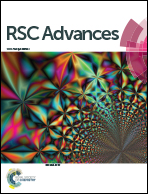Insight into the inhibition mechanism of kukoamine B against CpG DNA via binding and molecular docking analysis†
Abstract
Kukoamine B (KB) was found to inhibit the over-production of pro-inflammatory cytokines induced by immunostimulatory CpG DNA, thus being considered as a valuable candidate for the development of anti-sepsis drugs. With the goal of elucidating the mechanism of inhibition of CpG DNA by KB, dual polarization interferometry and isothermal titration calorimetry were used to measure the kinetic and thermodynamic parameters of KB–CpG DNA interaction, and molecular docking was employed to predict the binding mode. The significant binding of KB to CpG DNA led to a conformational change of the CpG DNA layer on the biosensor chip surface and produced a dissociation equilibrium constant (KD) of 4.82 × 10−7 M. The thermodynamic profile elucidated two-site binding, a strong binding of the first site and weaker binding of the second one, which was driven by enthalpy and entropy. Further, docking results suggested that KB formed a close contact with the core sequence of CpG DNA. Taken together with these results, we gained insight into the inhibition mechanism of KB against CpG DNA through direct binding measurement and in silico simulation. KB could bind the primary structure of CpG DNA, thereby interfering with the interaction of CpG DNA with Toll-like receptor 9 (TLR9) and the immunestimulatory effect.


 Please wait while we load your content...
Please wait while we load your content...